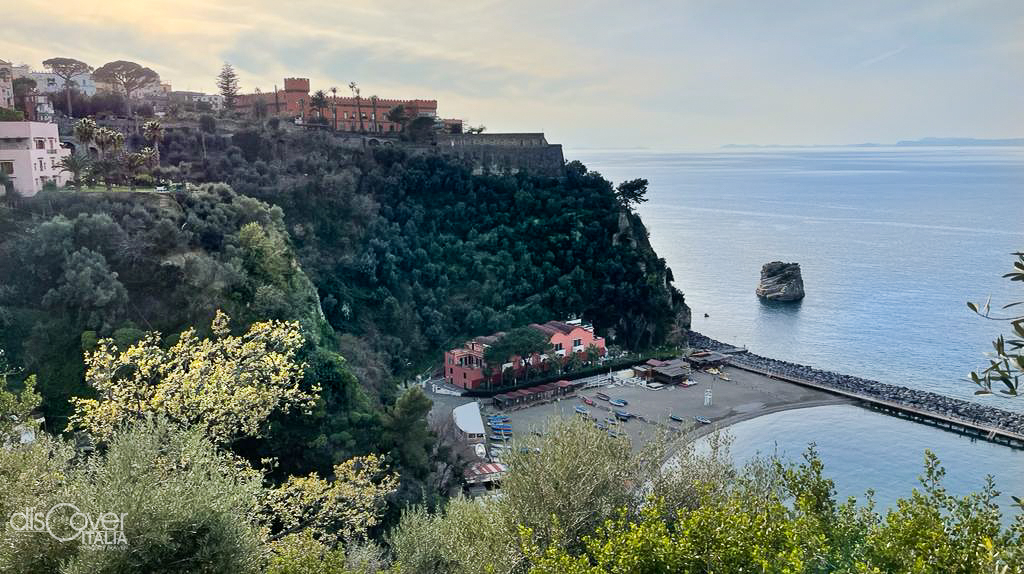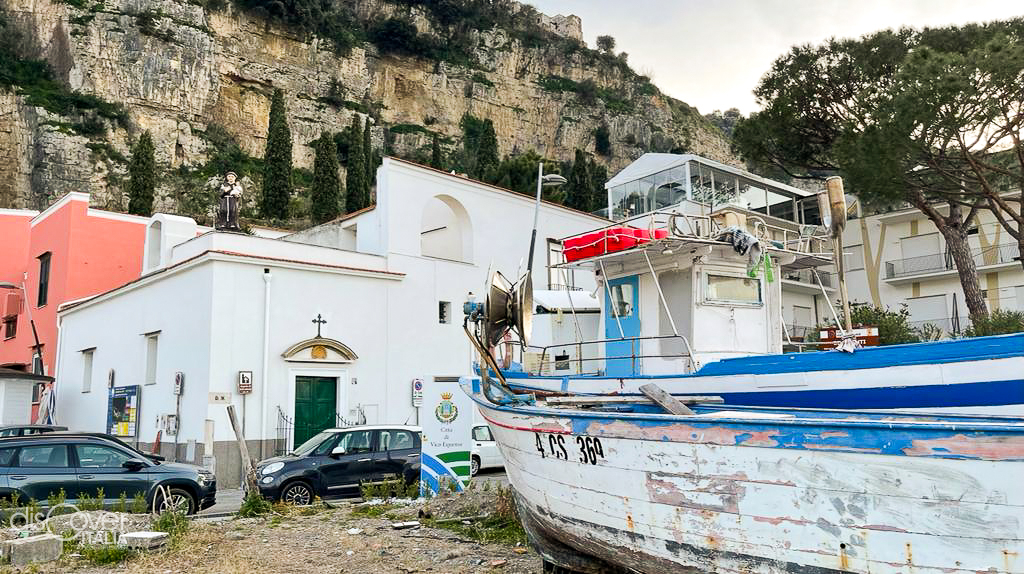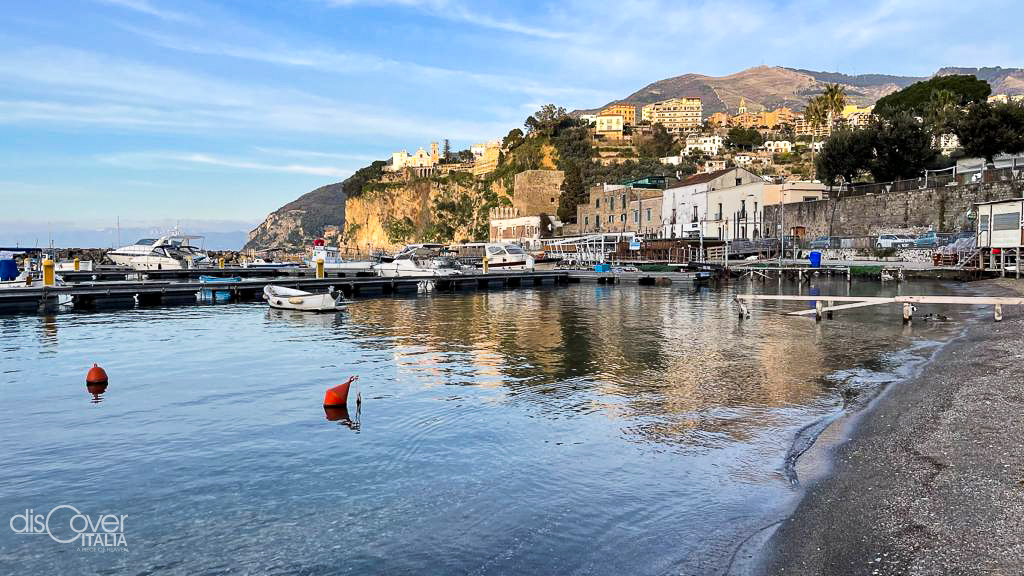Arriving from Naples, the first step of the Coast is Vico Equense, set in the rocks, which overhang on the sea.
Monte Faito, the highest peak (1100 meters) of the mountain chain of Monti Lattari, with its forests plenty of rare trees species such as the white fir, dominates the view. The name of the place owes its origins to Aequana, the ancient maritime village. Today’s name comes from the union of vicus, village, to the adjective equensis, derived from Aequana.  The atmosphere of Vico is very peculiar: small streets, views and hamlets, between hilly areas and littoral parts. The territory is the vastest of the Sorrentine peninsula and in order to admire it, you can start from the thirteen hamlets you meet going up the street leading to the Faito: a fascinating way characterised by secular settlements and events. For example, the one linked to the foundation of the district of Massaquano, the most ancient between the villages, which owes its name from a group of refugees escaped from the Turks persecutions in the 9th century.
The atmosphere of Vico is very peculiar: small streets, views and hamlets, between hilly areas and littoral parts. The territory is the vastest of the Sorrentine peninsula and in order to admire it, you can start from the thirteen hamlets you meet going up the street leading to the Faito: a fascinating way characterised by secular settlements and events. For example, the one linked to the foundation of the district of Massaquano, the most ancient between the villages, which owes its name from a group of refugees escaped from the Turks persecutions in the 9th century. 
 There are also several churches of artistic and architectonic interest: in Moiano, the highest district, there is the Church of San Renato, which preserves a statue of the saint dating back to 16th century. Arola is at the foot of Monte Ferano, and it is well known because in its area there is the ancient Camaldolese hermitage, in a perfect position, in the locality of Astapiana: you can access the complex, completed in 1607, from a low crenelated tower. Another important place to visit is the Parish of Sant’Antonino, the most imposing religious edifice of the hamlets. The district of Seiano is one of the most populated and important, on the hillside which almost divides the two Municipalities of Vico and Meta.
There are also several churches of artistic and architectonic interest: in Moiano, the highest district, there is the Church of San Renato, which preserves a statue of the saint dating back to 16th century. Arola is at the foot of Monte Ferano, and it is well known because in its area there is the ancient Camaldolese hermitage, in a perfect position, in the locality of Astapiana: you can access the complex, completed in 1607, from a low crenelated tower. Another important place to visit is the Parish of Sant’Antonino, the most imposing religious edifice of the hamlets. The district of Seiano is one of the most populated and important, on the hillside which almost divides the two Municipalities of Vico and Meta.  You must see the Church of Santa Maria Vecchia and the Parish of San Marco. The ancient cathedral of Church of Santissima Annunziata constitutes the unique example of a gothic church on the Coast: it is overlooking the sea and it has been built under the wished of Bishop Giovanni Cimmino between 1320 and 1330. The façade, rebuilt many times, is from the eighteenth century. It appears in the old town, the interior has three naves: the central one guards important art works such as the paintings of Giuseppe Bonito, the sarcophagus of bishop Cimmino and the tomb of Gaetano Filangieri, famous economist who lived and died in the Giusso castle in the second half of the 18th century. Of considerable interest is also the Sanctuary of Santa Maria del Toro, whose foundation in 1530 as a votive chapel – according to the legend – is due to miraculous episodes of the discovery of an image of Virgin Mary in a grotto. The interior is with a single nave. Therefore, on the Equense panorama, you can see the Giusso Castle with its original architecture dating back from the fourteenth century is an Angevines’ work. Under the Carafa, the castle was enlarged. In 1535-40, Federico Carafa built a baronial palace, which corresponds to the actual main building. In 1828, the complex was bought by Luigi Giusso and from 1935 to 1973, the Company of Jesus was installed there. There is also the Antiquarium, which keeps archaeological material coming from a necropolis discovered in the urban area and dating from the 7th century to the Vth century b.C and the Campanian Mineralogical Museum, which guards samples of almost 3500 minerals coming from all over the world and collections of the engineer Pasquale Discepolo. On the Vico coast, the Thermal Baths of the Scrajo must be remembered, founded in 1895 by Pietro Scala on a source already known in the Imperial age.
You must see the Church of Santa Maria Vecchia and the Parish of San Marco. The ancient cathedral of Church of Santissima Annunziata constitutes the unique example of a gothic church on the Coast: it is overlooking the sea and it has been built under the wished of Bishop Giovanni Cimmino between 1320 and 1330. The façade, rebuilt many times, is from the eighteenth century. It appears in the old town, the interior has three naves: the central one guards important art works such as the paintings of Giuseppe Bonito, the sarcophagus of bishop Cimmino and the tomb of Gaetano Filangieri, famous economist who lived and died in the Giusso castle in the second half of the 18th century. Of considerable interest is also the Sanctuary of Santa Maria del Toro, whose foundation in 1530 as a votive chapel – according to the legend – is due to miraculous episodes of the discovery of an image of Virgin Mary in a grotto. The interior is with a single nave. Therefore, on the Equense panorama, you can see the Giusso Castle with its original architecture dating back from the fourteenth century is an Angevines’ work. Under the Carafa, the castle was enlarged. In 1535-40, Federico Carafa built a baronial palace, which corresponds to the actual main building. In 1828, the complex was bought by Luigi Giusso and from 1935 to 1973, the Company of Jesus was installed there. There is also the Antiquarium, which keeps archaeological material coming from a necropolis discovered in the urban area and dating from the 7th century to the Vth century b.C and the Campanian Mineralogical Museum, which guards samples of almost 3500 minerals coming from all over the world and collections of the engineer Pasquale Discepolo. On the Vico coast, the Thermal Baths of the Scrajo must be remembered, founded in 1895 by Pietro Scala on a source already known in the Imperial age.
Copyright video, foto e testi © 2020




Comments powered by CComment